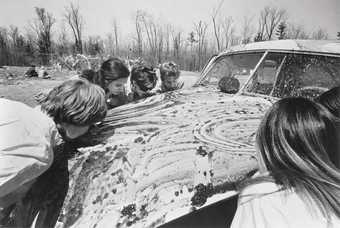
Sol Goldberg's photograph of participants in Allan Kaprow's 'Women licking jam off a car,' from his happening 'household' (1964)
Courtesy Getty Research Institute
© Estate of Sol Goldberg
In the late 1950s and early 1960s, happenings made New York City the happening place to be.
The term was coined by Allan Kaprow, an artist and lecturer who had studied painting with one of the key exponents of Abstract Expressionism, Hans Hofmann, in the 1940s. Unlike the influential critic Clement Greenberg, Kaprow was less interested in the art object than in the way they were created: he was excited by the performative possibilities of painting.
Hans Namuth’s 1951 photos and film of Jackson Pollock making his paintings illustrated a new direction for Kaprow, where the artist was within the work, while making the work. After Pollock’s death, Kaprow wrote an essay on the legacy of Pollock: exploring what he thought Pollock had meant for painting, art and life. He suggested that the art to come was one that incorporated everyday life, and everyday objects.
In 1957 Kaprow went on a mushroom hunt with artists, composers and founder members of the Fluxus group George Brecht and John Cage. Struggling with some of the sound elements in his own works (which he called action collages), Kaprow asked Cage’s advice. Cage invited him along to his composition class at the New School for Social Research in New York and, fascinated by what he heard about recording, editing and looping tape, Kaprow asked if he could attend regularly. Cage’s weekly homework was to create a piece of work and in response Kaprow began to create full-scale events that he called 'happenings'.
In 1959 he presented 18 Happenings in 6 Parts at the Reuben Gallery in New York – the first opportunity for a wider audience to experience this sort of event. He chose the word happening to suggest ‘something spontaneous, something that just happens to happen’.
Despite their name, happenings were actually tightly planned and participative. Like the Black Mountain untitled event of 1952, the environments, actions, sound, light and the timing were all integral parts of 18 Happenings in 6 Parts. Rather than being passive observers, the audience were participants – invitations to the event said ‘you will become part of the happenings; you will simultaneously experience them’. Once people arrived at the second floor loft space of the Reuben Gallery they were given a programme of events, and instructions on how to behave, including when to take their seats or move between the three spaces, or when applause was appropriate (at the very end only). Lasting for ninety minutes, the eighteen simultaneous performances included painters painting on canvases, a procession of performers, readings from placards, the playing of musical instruments, and ended with two performers saying single-syllable words like 'but' and 'well' as four huge scrolls fell from a horizontal bar between them. The end of the event was signalled by a bell ringing twice.
In many ways these events brought out the ideas of chance encounters, and of giving significance to everyday events. As Cage’s 4’ 33’’ offered a found sounsdcape, and potentially changed the listeners’ relationships to the ‘noise’ they heard after the performance, these participatory events blurred the line between what was life and what was art, what was an everyday movement and what was a performance. Kaprow said, ‘The line between art and life sould be kept as fluid, and perhaps as indistinct as possible’. No doubt some were bemused by the goings on, and what to make of them, but regardless, happenings took off.
Fashionable people attended Kaprow’s events, which help to popularised the term 'happening' as a way to describe something that was cutting edge or cool. Until it was cool no longer. By 1966, it was mainstream enough for The Supremes to use it as the title for a song. In the end, Kaprow himself dropped the term.
I’d already repudiated the word, because many other people before that were using it. It was a catch word. You remember everybody went around going, 'What’s happening, baby?'
…I remember one ad showed a floating woman in outer space, a starry background, and the legend was, 'I dreamt I was in a happening in my Maidenform brassiere.'
So by that time movies and The Supremes and all were in general usage around the word in ways that had nothing to do with my original sense, which became so foreign to me that I just dropped it. However, it’s like your name, you can’t drop it without somebody coming and picking it up and saying, 'You dropped something mister.'
Kaprow may have made the term, and the idea of blurring the boundary of art and life, popular but he was the first to admit that he wasn’t the only one or the first working in this way.
The happening had its roots in Hugo Ball’s Dada Cabaret Voltaire, Surrealist performances and the Italian Futurists in the early years of the twentieth century. Creating art out of life was first proposed as the gesamstkunstwerk (total art work) by the composer Richard Wagner in the Art-Work of the Future in 1849-50.
In Tokyo, Jikken Kobo (Experimental Workshop), a collective of visual artists, composers, photographers, musicians, designers, writers and others were experimenting with cross-discipline presentations. Working between 1951 and 1958, Jikken Kobo members mixed dance, poetry reading, music, painting displays and architecture. From 1952, they used the term happyōkai (literally a recital), for all their events, regardless of the traditional art forms the events included.
Therefore, from their radical beginnings as forums for creative expression, to their eventual co-option by the mainstream, happenings reveal much about the wide cultural developments experienced during the 20th century, as well as the changing nature of art practice itself.
